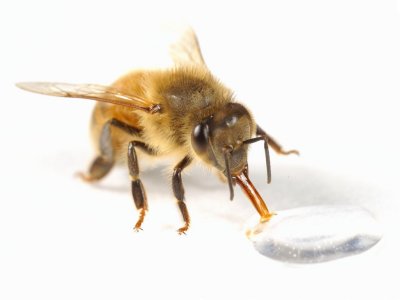Bombs Away! Homeland Security "Buzzes" with Bee Learning
Biology 342 Fall 2012
by Matthew Keeslar and Alexandra Bryn Mariani
References
Arenas, A. and W. M. Farina (2012). "Learned olfactory cues affect pollen-foraging preferences in honeybees, Apis mellifera." Animal Behaviour 83(4): 1023-1033.
Farina (2012). "Learned olfactory cues affect pollen-foraging preferences in honeybees, Apis mellifera." Animal Behaviour 83(4): 1023-1033.
Behrends, A. and R. Scheiner (2012). "Octopamine improves learning in newly emerged bees but not in old foragers." Journal of Experimental Biology 215(7): 1076-1083.
Brigandt, I (2005). The instinct concept of the early Konrad Lorenz. Journal of the History of Biology 38(3), 571-608.
Chittka, L. (1995). The influences of landmarks and distance estimation of honey bees (vol 50, pg 23, 1995). Animal Behaviour, 50, 1709-1710. Retrieved Dec, from Correction database.
Chittka, L., & Jensen, K. (2011). Animal Cognition: Concepts from Apes to Bees. Current Biology, 21(3), R116-R119. Retrieved Feb, from Editorial Material database.
Hammer, M. and R. Menzel (1995). "Learning and Memory in the Honeybee." Journal of Neuroscience 15(3): 1617-1630.
Lehmann, M., D. Gustav, et al. (2011). "The early bee catches the flower - circadian rhythmicity influences learning performance in honey bees, Apis mellifera." Behavioral Ecology and Sociobiology 65(2): 205-215.
Mc Cabe, S. I., & Farina, W. M. (2010). Olfactory learning in the stingless bee Tetragonisca angustula (Hymenoptera, Apidae, Meliponini). Journal of Comparative Physiology a-Neuroethology Sensory Neural and Behavioral Physiology, 196(7), 481-490. Retrieved Jul, from Article database.
Pankiw, T., & Page, R. E. (2001). Genotype and colony environment affect honeybee (Apis mellifera L.) development and foraging behavior. Behavioral Ecology and Sociobiology, 51(1), 87-94. Retrieved Dec, from Article database.
Raffiudin, R., & Crozier, R. H. (2007). Phylogenetic analysis of honey bee behavioral evolution. Molecular Phylogenetics and Evolution, 43(2), 543-552. Retrieved May, from Article database.
Raine, N.E., & Chittka, L. (2008) The correlation of learning speed and natural foraging success in bumble-bees. Proceedings of the Royal Society B-Biological Sciences 275 (1636), 803-808.
Reichle, C., S. Jarau, et al. (2010). "Recruits of the stingless bee Scaptotrigona pectoralis learn food odors from the nest atmosphere." Naturwissenschaften 97(5): 519-524.
Roselino, A. C., & Hrncir, M. (2012). Repeated unrewarded scent exposure influences the food choice of stingless bee foragers, Melipona scutellaris. Animal Behaviour, 83(3), 755-762. Retrieved Mar, from Article database.
Rossel, S. (1993). NAVIGATION BY BEES USING POLARIZED SKYLIGHT. Comparative Biochemistry and Physiology a-Physiology, 104(4), 695-708. Retrieved Apr, from Review database.
Vorel, C. A. and T. L. Pitts-Singer (2010). "The Proboscis Extension Reflex Not Elicited in Megachilid Bees." Journal of the Kansas Entomological Society 83(1): 80-83.
********************************************
Images by Page:
Header Honeycomb Image:
http://www.chrisbyrnes.com/2012/05/04/know-your-honey/
Home Page:
Bee on flower exhibiting PER:
www.mzephotos.com/gallery/insects/honey-bee-proboscis.html
Bee:
Mechanism:
Memory decay graph: Hammer and Menzel 1995
Conditioning of Proboscis Extension Reflex:
abidhussaini.com/info/research/pdh/project-1/honeybee-conditioning
Phylogeny:
Megachilidae rotundata:
http://cymobase.org/cymobase/species_list?char=M
Phylogenetic tree: http://www.sciencedirect.com/science/article/pii/S1055790308000547
Learning performance graph: Lehmann, Gustav et al. 2011
Ontogeny:
Bee on flower:
www.flickr.com/photos/robfon/2358526180/in/set-72157602821249418
Emerging bee:
http://www.extension.org/pages/61320/broodmapper:-honey-bee-development-and-citizen-science
Adaptive Value:
Bee on flower:
http://thenextweb.com/asia/2012/09/05/pollenizer-southeast-asia-startups/?fromcat=all&_suid=135241193420104016689653508365
Waggle dance diagram:
http://openlearn.open.ac.uk/mod/resource/view.php?id=387640
Bombs Away!
Many bees in “harnesses”:
https://www.orau.gov/cedr/site-information.aspx#.UJwnCM1zZhM
Bee in harness with q-tip:
www.sciencenews.org/view/feature/id/36333/title/Sting_Operation
References:
Bee exhibiting PER:
www2.warwick.ac.uk/fac/sci/lifesci/study/pg/research/currentstudents/hrrial/myresearch/
Video came from Los Alamos National Laboratory